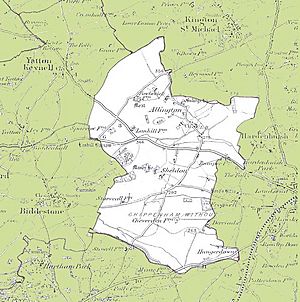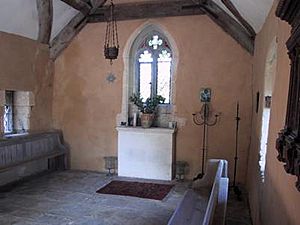Sheldon Manor facts for kids
Quick facts for kids Sheldon Manor |
|
|---|---|
 |
|
| Type | Manor House |
| Location | Wiltshire |
|
Listed Building – Grade I
|
|
| Official name: Sheldon Manor | |
| Designated | 20 December 1960 |
| Reference no. | 1022907 |
|
Listed Building – Grade II*
|
|
| Official name: Chapel to the south-east of Sheldon Manor | |
| Designated | 20 December 1960 |
| Reference no. | 1022908 |
| Lua error in Module:Location_map at line 420: attempt to index field 'wikibase' (a nil value). | |
Sheldon Manor is a very old and special house near Chippenham, in Wiltshire, England. It's the oldest manor house in Wiltshire where people still live! This amazing home dates all the way back to Anglo-Saxon times. Most of what you see today was built in the 1600s. It's so important that it's a Grade I listed building, meaning it's protected for its history.
Contents
A Look Back: Sheldon Manor's History
The area around Sheldon Manor has a long past. There used to be a village called Sheldon. People first wrote about it in the year 803! But by 1582, the village was empty. Today, you can still find signs of this lost village behind the Manor. The Manor itself stands where an even older home once was.
Who Owned Sheldon Manor?
In about 1180, a knight named Sir William de Beauvilain was given the manor of Sheldon. When he died, the land went back to the King. This happened because he was a Norman. Later, in 1231, King Henry III gave it to the de Godarville family.
The manor changed hands many times over the centuries. In 1250, Sir Geoffrey Gascelyn got it when he married Joan de Godarville. Then, in 1424, it was sold to Sir Walter Hungerford. For a while, it was even given to Catherine Parr, one of King Henry VIII's wives!
For many years, different families rented the property. In 1684, Sir Edward Hungerford sold the Manor. William Norris bought it in 1711. His last family member living there passed away in 1828.
In 1854, Sir Gabriel Goldney bought the Manor. His son lived there until 1911. After that, the Bailey family owned it for a time.
Since 1917, the Gibbs family has owned Sheldon Manor. Major Martin Anthony Gibbs and his wife Elsie Margaret Mary lived there with their six children. Mrs. Gibbs even wrote a book about the Manor's history in 1982.
Today, Sheldon Manor is part of the area called Chippenham Without. People have lived in Sheldon Manor without a break since 1282. This makes it Wiltshire's longest continuously lived-in manor house! Because of its history, it became a Grade I listed building in 1960. This means it's a very important historical site.
Exploring Sheldon Manor: Architecture and Treasures
The oldest parts of Sheldon Manor are a window on the west side and the porch. These parts might be from the late 1200s! A famous expert named Pevsner thought the porch was "amazing." He also said it was "much too big" for the house as it is now.
Most of the main house was built around 1659. It has two and a half floors. It's made of rough stone and has stone-tiled roofs. Some parts are even older than 1659. Later changes were made after 1711 and around 1911.
Special Outdoor Features
In the grounds, there is a small stone chapel. People believe it was built around 1450 by the Hungerford family. They used it for themselves and their workers. It has a beautiful east window with Perpendicular tracery. For a long time, it was used as stables. But in the 1900s, it was fixed up.
You can also see a brick building called a storehouse. It stands on special stone pillars called staddle stones. These pillars kept rats from getting into the stored food!
Amazing Collections Inside
Sheldon Manor is home to many interesting collections. You can find beautiful Nailsea glass items there. There are also Persian saddlebags and delicate porcelain. The house has lovely oak furniture too. This includes a very old Elizabethan refectory table and chairs.
The Manor also has impressive paintings. You can see art by Tissot, David Teniers, and Bassano. There are also special vases made by William De Morgan. And don't forget "an unusual collection of glass walking sticks!"
Sheldon Manor Today
Sheldon Manor was the first winner of the AA/NPI Historic House Awards. It won for its "architectural integrity and warm welcome." This means it's a beautiful old building that makes visitors feel welcome.
The gardens at Sheldon Manor are open to the public. You can explore a wonderful rose garden and ancient yew trees. There's also an arboretum, which is like a tree museum. You might even spot some mulberry bushes! The house itself is not usually open for tours.
Sheldon Manor is a popular place for weddings. It also hosts summer plays by Shakespeare and operas in its beautiful grounds. It's also involved in a special project. This project helps to protect the Cleveland Bay horse. This horse is an endangered breed, meaning there are not many left.
In 1988, The New York Times newspaper wrote about the owners of the house. They said the owners made Sheldon Manor feel like a "living organism." This means it felt like a home that was still alive and connected to its past. It wasn't just an old building.
Sheldon Manor has even been in movies and TV shows! In 1995, it was used as Uppercross in the BBC movie Persuasion. In 2008, it appeared in the BBC One show Bonekickers.
In the 1980s, the "Shakespeare at Sheldon" festival took place here every summer. The Gibbs family helped organize it. The stage was set up above the swimming pool. Tennis courts were used for dressing rooms. Special seats were put in for the audience. A thick hedge helped actors move around unseen.
Images for kids




